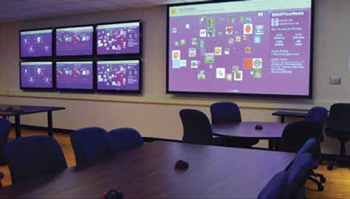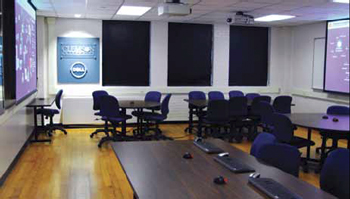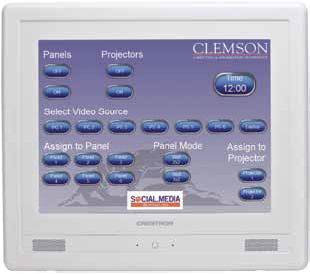Social Media Surveillance

Behind the Scenes at the Revolutionary Clemson University Social Media Listening Center
So far both the Radian6 and Crestron systems have been extremely reliable, according to Chuck Heck, CTS. “If they have a problem, they can call me or the IT help desk, but I don’t believe there’s ever been a call.”It’s the latest trend in high-tech customer interaction. Social media listening systems allow corporate or public entities to search out mentions of specific products or concepts in billions of entries on Facebook, Twitter, YouTube, blogs, news, and photo sites, then listen, track, and respond to them.
Although many Fortune 500 companies participate in social media listening, just four organizations have taken these tools to their ultimate level, building social media command centers to track and respond to online feeds. Among them is Clemson University in South Carolina, which opened its command center in February. This center may be the most powerful of any social media listening post, combining six PCs tied to Radian6 servers, with a digital switching system from Crestron able to reconfigure the setup in seconds.
“The other social media listening centers have PCs used by single operators, each connected to a single display,” explains Chuck Heck, CTS, of Clemson’s internal AV Systems Design and Engineering group. “We use our room for multiple teaching and research purposes, and instructors need to be able to reconfigure it quickly.”
“Listening” to Social Media
According to Jason Thatcher, the faculty lead for the Clemson Listening Center, the room has been used so far for a variety of exercises and individual and group research projects, ranging from public perceptions of the Clemson athletics programs to an effort to predict changes in stock prices. “We’re really still learning what the technology can do,” he explains.
The power of the system is immense. Based on Radian6 software tied to the company’s servers, it tracks and indexes material from over 200 million social media feeds and allows researchers to do Boolean key phrase searches on all of them. “It’s a huge dynamic database, and it keeps growing,” Thatcher explains. “We can search virtually anything that’s ever been posted on or fed through a public site.”
A daily selection of features, industry news, and analysis for tech managers. Sign up below.
Radian6 developed their system primarily to help large companies track and participate in conversations about their products on the social web. Clients can use the system to track the “buzz” a product (or anything else) may generate, measuring how many times it is talked about in social media, including whether it is mentioned in a positive or negative context. Clients can also use Radian6 to identify specific comments and track how specific individuals talk about their products across different platforms. The goal here is to seek out happy or unhappy customers, reply to their comments, and in many cases try to solve whatever problems they may have.
Designing the Center
Because the Clemson Listening Center is used for many different types of research and research-based classes, Heck says it took him a while to understand what kind of audio video system would best help its users. “Part of what we were talking about was a NOC [a Network Operations Center] and part of it was a classroom. Once I realized that I needed to combine those two concepts, everything fell into place.”


The system tracks and indexes material from over 200 million social media feeds and allows researchers to do Boolean key phrase searches.Four of the Radian6-connected computers at Clemson are used most often to show dynamic visualizations of the data: one helps researchers visualize sentiment expressed about the terms in question, one shows summary metrics, one shows influencers, that is, people who generate large numbers of comments and have large followings, and one shows the search terms’ geographic reach. The two others normally make up an “engagement console” and can be used to contact individual people by commenting on their feeds.
In the end, Heck designed a system with six 47-inch LG LED monitors hanging on one wall in an area primarily used for research, and two Panasonic PT-DZ570 projectors for seminar-style classes, one at each end of a conference table with seating for up to 18. He used a Crestron control system to make reconfiguring the room easy and an 8x8 Crestron DigitalMedia switcher to route computer signals to the monitors and projectors.
With this configuration, it’s possible for class participants to see all eight screens at once, although it’s easier to read whatever an instructor switches to the two big screens. The instructor also has an input for his or her own laptop.
“The Crestron touchscreen lets us move very quickly across different visualizations,” Thatcher says. “I may set up the room with captures of four interesting screens for students to view as they come in, leave two feeds live, and then start looking at various feeds on the projector.”
Heck says he chose a 12-inch Crestron touchscreen for the room’s controls, large enough to include all of the main functions on a single screen. All the instructor has to do is touch one button for a computer source, then another for the display or projector he wants it to appear on. In this way he can put any source on any or all screens in seconds.
The DigitalMedia switcher, Heck says, was an obvious choice, as it allows Clemson to put all of the center’s audio and video signals on a dedicated IP network. “It was a quick and easy installation. Our Network Services guys came in and ran the cable, an AV tech plugged everything in and then I programmed it. The system is easy to use, reliable, and it just works.”
Heck says he tied the six computers to the switcher with standard HDMI cables. For the laptop input, he used a Crestron DigitalMedia transmitter and Cat6 cable, providing both HDMI and VGA inputs. To ensure optimum images from the monitors and projectors, he used Cat6 cable and Crestron DigitalMedia receiver/scalers. He also included an occupancy sensor to turn off the monitors and projectors if there is no activity in the room for an hour. “Our users sometimes forget to turn the system off, and this is a very simple solution to that problem.”

This center may be the most powerful of any social media listening post, combining six PCs tied to Radian6 servers, with a digital switching system from Crestron able to reconfigure the setup in seconds. The touchscreen lets user move quickly across different visualizations.Heck adds that the users did not want the monitors perceived as a video wall, but he went ahead and used the video wall function that the Crestron switcher includes. “They felt that new students should see each of these feeds as a separate data source, and so we used standard-bezel displays and separated them an inch or two from each other. But still, I gave them the ability to spread one PC across four of the screens or all six. It makes a great impression when they have visitors.”
Equipment List: Clemson University Social Media Listening Center
* 2 Panasonic PT-DZ570 Projectors, 1920x1200, 4,000 lumen
* 6 LG 47LE530C 47-inch LED display, 1020 x 1080
* 6 Dell Optiplex 990 Tower w/Intel Core i3 processor
* 1 Crestron DM-MD8x8 DigitalMedia Switcher
* 6 Crestron DMC-DVI DVI Input Card
* 1 Crestron DMC-C-DSP 8G+ Input Card with Surround Sound Down Mixing
* 2 Crestron DMCO-55 8G+ Output Card with 2 HDMI outputs
* 1 Crestron DM-TX201-C 8G+ Transmitter
* 7 Crestron DM-RMC-SCALER 8G+ Receiver with scaler
* 1 Crestron DM-RMC-200-C 8G+ Receiver
* 1 Crestron CP2E Control Processor
* 2 Crestron CNPWS-75 Power Supply
* 1 Crestron TPMC-V12-W 12-inch V-Panel Touch Screen
* 2 Dalite 60x96 Cosmo Electro
* 2 Dalite LV Control
* 2 Dalite Ceiling Trim
* 2 Chief RPMA278 Projector Mounts
* 6 Chief LSMU Panel Mounts
* 2 Surgex SX1120RT Crestron/PC Power Filter (Rack)
* 1 SOLA STV25K Display Panel Power Filter (Wall Circuit)
* 6 Extron MDC HDMI 3 foot HDMI Cable
* 2 Extron HDMI DVI-D/3 3 foot HDMI-DVI Cable
* 4 Extron HDMI DVI-D/6 6 foot HDMI-DVI Cable
* 2 Extron HDMI DVI-D/12 12 foot HDMI-DVI Cable
* 1 Extron 15 pin-15 pin VGA AAP VGA pass-thru
* 1 Extron HDMI-HDMI w/10” pigtail HDMI pass-thru
* 1 Extron 3.5 mm Mini-jack/Solder Audio jack
* 1 Extron Plate Blank Plate
* 1 Extron AAP 102 AAP Frame 2 Gang
* 1 Miscellaneous Cables and Connectors Lot
Is the System IT or AV? Or Both?
The system was relatively simple to build. “We are lucky in that we have a really good relationship with our network support staff,” Chuck Heck says. “In some organizations, if you introduce an IP-based network like DigitalMedia, you’re going to see a defensive attitude, and for that reason DM is sometimes separated from the enterprise network.” At Clemson, however, DigitalMedia is part of the university system and managed by its IT staff using standard maintenance protocols.
Clemson IT has configured a building automation network which is separate from the public network that students and faculty use, and the university’s DigitalMedia and Crestron control systems run on that. Out of the box, DigitalMedia comes configured for residential applications, and so some settings (in particular a spanning tree protocol) must be changed to work in an enterprise situation. Once you’re aware of that, Heck says, anyone with an IT background can easily set it up.
ROI and the Clemson Social Media Listening Center
The potential return on the Clemson Social Media Listening Center is huge. “We’ve had a number of corporate CEOs come in look at it, to try to understand its value as a research tool,” Chuck Heck says. Faculty, led by Jason Thatcher, have begun to write grant proposals, and there’s little doubt sponsored research will more than pay for the cost of the facility.
Financial return is not, however, the purpose of the installation. “The real value is in the research we’re doing, and the most meaningful return is in the caliber of faculty and students that attracts,” Thatcher explains.
Don Kreski is president of Kreski Marketing Consultants. Reach him at donkreski@kreski.com.
